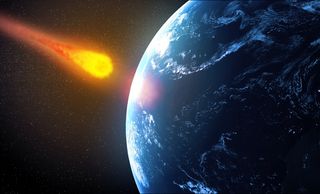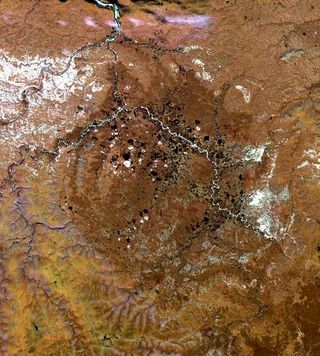
Russia's Popigai Meteor Crash Linked to Mass Extinction

SACRAMENTO, Calif. — New evidence implicates one of Earth's biggest impact craters in a mass extinction that occurred 33.7 million years ago, according to research presented here Wednesday (June 11) at the annual Goldschmidt geochemistry conference.
Researchers from the University of California, Los Angeles precisely dated rocks from beneath the Popigai impact crater in remote Siberia to the Eocene epoch mass extinction that occurred 33.7 million years ago. Popigai crater is one of the 10 biggest impact craters on Earth, and in 2012, Russian scientists claimed the crater harbors a gigantic industrial diamond deposit.
The new age, which is later than other estimates, means the Eocene extinction — long blamed on climate change — now has another prime suspect: an "impact winter." Meteorite blasts can trigger a deadly global chill by blanketing the Earth's atmosphere with tiny particles that reflect the sun's heat. [Crash! 10 Biggest Impact Craters on Earth]
"I don't think this will be the smoking gun, but it reopens the door to Popigai being involved in the mass extinction," said lead study author Matt Wielicki, a UCLA graduate student.

This isn't the first time flying space rocks have been implicated in the Eocene's mass die-offs. Other possible culprits besides Popigai crater include three smaller Earth-meteorite smashups between 35 million and 36 million years ago: Chesapeake Bay crater offshore Virginia, Toms Canyon crater offshore New Jersey and Mistastin crater in Labrador, Canada.
Previously, all four craters were ruled out because of their ages. Earlier dating attempts had pinned Popigai's impact age at 35.7 million years ago, Wielicki said. And 2 million years is too much of a time lag between a meteorite blast and disappearing species, he said. The cosmic impact that killed the dinosaurs 65 million years ago coincides in time with its extinction by just 33,000 years, according to the most precise dating techniques available.
With no meteorite to blame for the Eocene mass extinction, scientists focused on climate change. In this case, global cooling killed off many species, researchers think.
Sign up for the Live Science daily newsletter now
Get the world’s most fascinating discoveries delivered straight to your inbox.
Here's how they can tell: By measuring isotopes of oxygen, carbon and other elements in Eocene-age rocks, researchers can estimate Earth's past temperature and greenhouse-gas levels. (Isotopes are elements with different numbers of neutrons in their nuclei.) The signal from the Eocene shows the epoch started off extremely warm and then swung toward colder, drier conditions before the big extinction event. However, a sharp spike in these climate signals at the end of the Eocene hints at short-lived but extreme global cooling, followed by a rebound to warmer temperatures.
"The age of the crater matches perfectly with that [short-term] global change," Wielicki said.
Wielicki thinks the Popigai impact created a global icehouse, similar to the climate disasters seen after enormous volcanic eruptions or the dinosaur-killing impact. The meteoritic crash could have pumped massive amounts of sunlight-reflecting sulfur droplets into the atmosphere, he said. The planet's "quick" recovery, in geologic time, set plants and animals on an evolutionary path to modern species.
The end of the Eocene was the last big mass extinction in Earth's history. More than 90 percent of snails disappeared, sea urchins were hard hit and the earliest toothed whales died off, which eventually would be replaced by modern whales. The dramatic shift of European mammals, called the "Grand Coupure," occurred soon afterward, following Eocene-Oligocene transition.
Email Becky Oskin or follow her @beckyoskin. Follow us @OAPlanet, Facebook and Google+. Original article at Live Science's Our Amazing Planet.
